Basis Peak: Fitness Tracker Review

Editor's Note: On Aug. 3, 2016, the Basis Peak was recalled because of the risk that the device may overheat and cause skin blisters or burns. It is no longer being sold.
The Peak is the latest fitness tracker from Basis, and the wrist-worn device aims to provide users with a number of insights into their daily activities while motivating them to live healthier lives. This tracker is our "Editors' Choice" among all the fitness trackers we've tested because not only does it track a vast array metrics, such as perspriation levels, but also we found it to be one of the more motivating fitness trackers to use.
Like the previous Basis B1 fitness tracker, the Peak tracks heart rate throughout the day, but the new device features improved sensors that allow it to keep track of your heart rate while you exercise, without a chest strap. In this regard, the device is similar to the Samsung Gear Fit, and the upcoming Apple Watch and Fitbit Charge HR, which will also monitor heart rate during exercise. I wore the Peak for about a week, to test out its features.
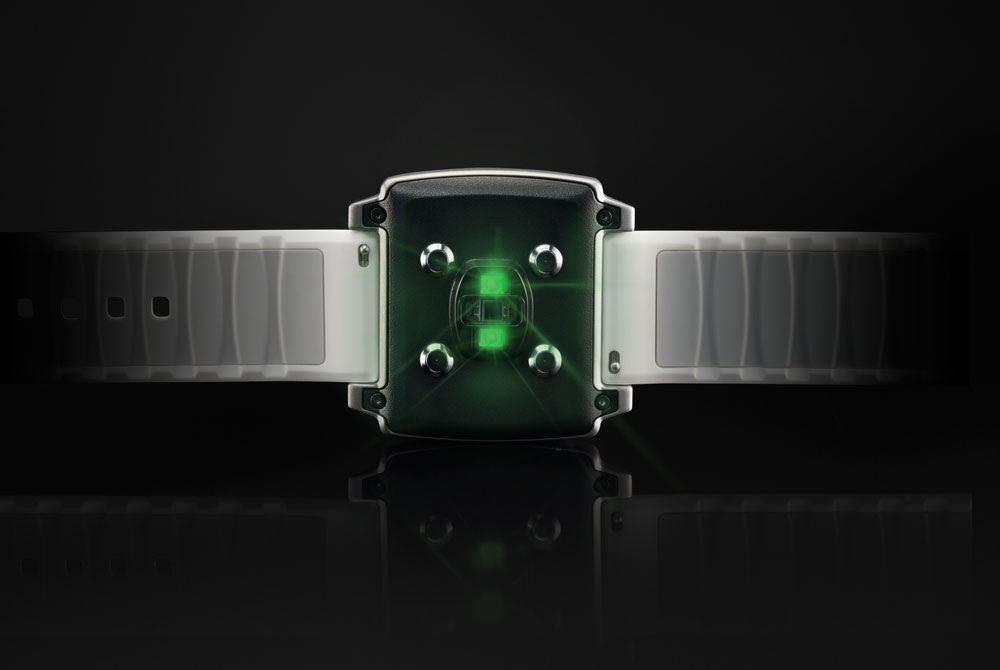
Unlike many other fitness trackers, the Peak doesn't need to be put into sleep mode — it automatically detects when you're sleeping. It also automatically detects certain activities, such as running, walking and cycling, and tells you the duration of your activity as well as how many calories you burned. The Peak is also one of the only trackers to measure skin temperature and perspiration. At about $200, the Peak is on the high end of the price range for fitness trackers. [Best Fitness Trackers]
The company says that the Peak will soon have some smartwatch capabilities, such as the ability to receive notifications for incoming calls and texts. These features will be included in a future software upgrade.
Overall Rating: 7.5/10
The pros of the Peak include a screen that doesn't require button pushes to see the time, automatic detection of activities, including running, cycling and sleep, and the ability to track heart rate during exercise.
The cons of the Peak include the lack of an alarm, the lack of a way to track distance in miles/kilometers, and the omission of a way to share your information on social media.
Sign up for the Live Science daily newsletter now
Get the world’s most fascinating discoveries delivered straight to your inbox.
Design/Comfort: 8.5/10
Compared with the previous Basis tracker, the Peak features a number of design improvements. Perhaps the biggest change is that the device doesn't have any buttons — instead, it has a touch screen. In addition, the device's screen is always on, so you don't have to push any buttons to see the time of day. (Many other fitness trackers require a button push to see the time.) And because the Peak can detect when you are exercising, the device will automatically show your steps, activity duration and heart rate, all in one screen, without any button pushes. This is very convenient when you're running or cycling, or just have your hands full.

The device's black-and-white display is large and easy to read, even in daylight. The Peak's screen also has a backlight so you can read it at night, but this does not turn on automatically. You have to swipe up on the right-hand side of the screen to turn on the backlight. I found that I would sometimes accidentally turn on the backlight when swiping on the screen to view my stats.
The Peak's breathable silicone strap feels soft and comfortable, and it can be adjusted to fit various wrist sizes. The straps come in only two colors, white/gray and black/silver, but you can also use your own watch straps if you wish, as the Peak has standard 23-millimeter watch-strap attachments.
However, the Peak's watch face comes in only one size, and it is rather large. As a petite female with small wrists and arms, the Peak looked big on me, and felt a little heavy. In contrast, the Apple Watch is expected to come in two sizes, including one for smaller people.
The Peak is waterproof up to 165 feet, so you can take it swimming. It is also fairly easy to charge — it snaps into its magnetic charging cradle, which connects to a computer or USB hub. It has up to four days of battery life.
Weirdly, the Peak doesn't have an alarm, which I would expect in a device of this price. But it does have the capability to vibrate, so perhaps an alarm will be included in a later software upgrade.
User Friendliness: 7/10
To set up your device, you have to download the Basis Peak app, which is available for iOS and Android. The app walks you through the setup, but there is no additional video explaining how to use the device. I thought a video or an illustration of how to use the device would have been nice — it's not a particularly complex device to use, but there is a lot of swiping left/right and up/down on the screen that is required to view different stats, turn on the backlight and sync the device, and as a user you are essentially left to figure all of this out on your own.
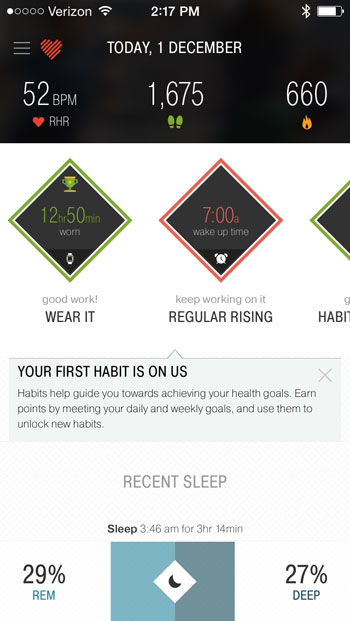
By default, the main screen shows the time, and if you tap on the screen it also displays the date. You swipe left to view your heart rate, and swipe left again to view your recent activity. Swiping down from the heart rate screen also shows your total steps and calories burned for that day.
I found the device easily detected when I was walking or running. However, it sometimes took a while to measure my heart rate, and sometimes I could not get a reading. This may have been because the device was slightly loose on my wrist.
The app has a main dashboard that provides an overview of your daily activity (steps taken and calories burned), and also shows your recent exercise and recent sleep, as well as how you are progressing toward meeting selected goals, which Basis calls "Habits" (more on this later).
You can also view charts of your daily activity within the app, which shows you the time of day you were active, along with your heart rate, steps and calories burned. You can also choose to view your skin temperature and perspiration on the same graph. And you can zoom in on a particular part of the day to see your activity more easily. You can also hold your finger down on the graph to show your stats at a particular point in time, and then slide your finger along the graph to see how the stats change over time.
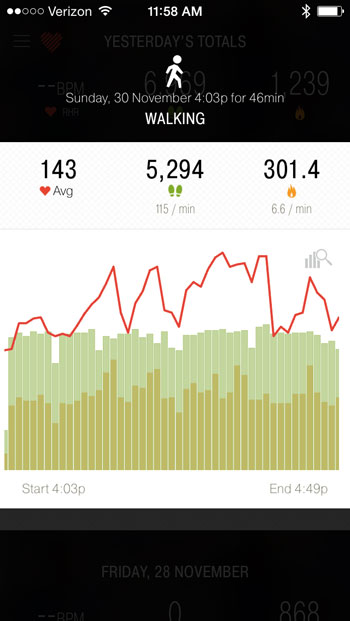
The Peak was good at detecting when I was asleep. But I found that the app would sometimes break up my sleep charts — instead of showing me one chart of my sleep for an entire night, it would show me two charts, each a few hours long. This was rather annoying, as it meant I could not get an overall picture of a single night's sleep.
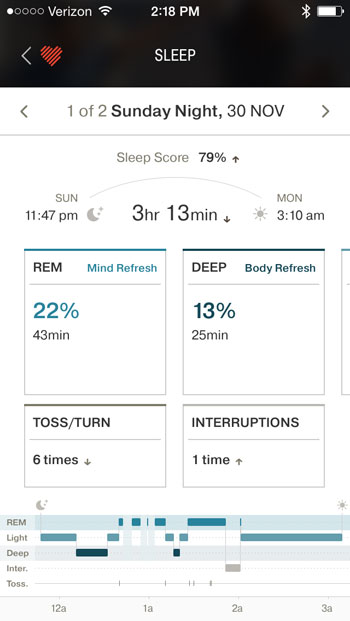
I had one problem while using the Peak — when I first started to use the device, it did not display my calories burned, no matter how long I wore it. I was told this was a bug, and that the company was working to fix it. The support team provided me with a quick fix: I simply needed to change my height and weight information in the app, sync the device, then change the information back and sync again. My Peak tracked my calories after that.
Value of Information: 6.5/10
Within the Habits section of the app, Basis provides preset goals, each with an explanation of why that particular goal will make you healthier. For example, the Habit "Don't Be a Sitter" says "taking breaks to get up and move around, even briefly, can counteract the adverse aftermath of a sedentary job." The app also provides a few tips on how to reduce sitting time. I also liked the Habit "Regular Rising," which says "climbing out of bed the same time every morning (even on weekends) is the best way to establish a healthy and strong daily cycle."
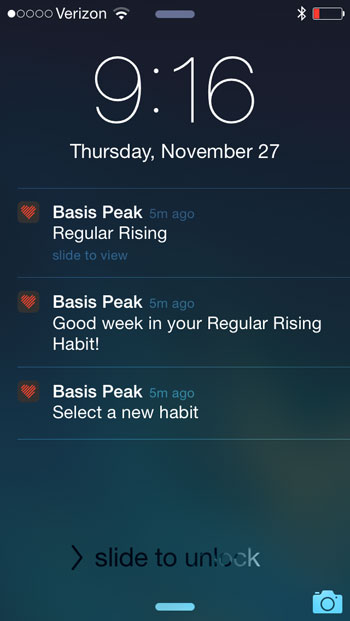
This information is a good start, and goes far beyond what many other fitness trackers provide in the way of explaining the goals they set for you. Still, I felt that the app could have done more to help explain what my individual stats meant, and how to improve. For example, although the Habit "Get More Sleep" says you should aim to get 7.5 to 9 hours of sleep per night, the app provides no information or tips on how to improve sleep. Also, Basis does not explain why knowing your skin temperature and perspiration would be useful.
Perhaps the biggest thing missing from the device is this: If you're interested in knowing how far you ran during a workout, you're out of luck. The Peak does not provide information about distance in terms of miles or kilometers. It only shows how many steps you took. Also, the Peak app does not provide a place to enter information about what you ate during the day, so it does not track your calorie intake.
Enjoyment/Inspiration: 8/10
Like the previous Basis trackers, the Peak excels in the motivation department. The Peak uses a point system to help you become healthier — each Habit is worth a certain number of points, and you need to earn points to unlock more Habits. I found this system very motivating. Also, every time you open the dashboard, the app shows you how close you are to competing your step or activity goal for the day. And the app will send push notifications to your phone to congratulate you on completing a goal.
However, the Peak does not appear to have a way to share your information on social media, or connect with friends, which may be a motivator for some.
Editor’s Note: In February 2015, we changed the rating system we use in our fitness tracker reviews from a 5-star system to a 10-point system. Not all of our ratings were a straight conversion (i.e. 2/5 stars = 4/10 points). Instead, we adjusted some of them in order to give our readers a better idea of how these devices perform in relation to each other.
More Reviews: See all our Fitness Tracker Reviews to find the best one for your needs.
Follow Rachael Rettner @RachaelRettner. Follow Live Science @livescience, Facebook & Google+.

Rachael is a Live Science contributor, and was a former channel editor and senior writer for Live Science between 2010 and 2022. She has a master's degree in journalism from New York University's Science, Health and Environmental Reporting Program. She also holds a B.S. in molecular biology and an M.S. in biology from the University of California, San Diego. Her work has appeared in Scienceline, The Washington Post and Scientific American.









